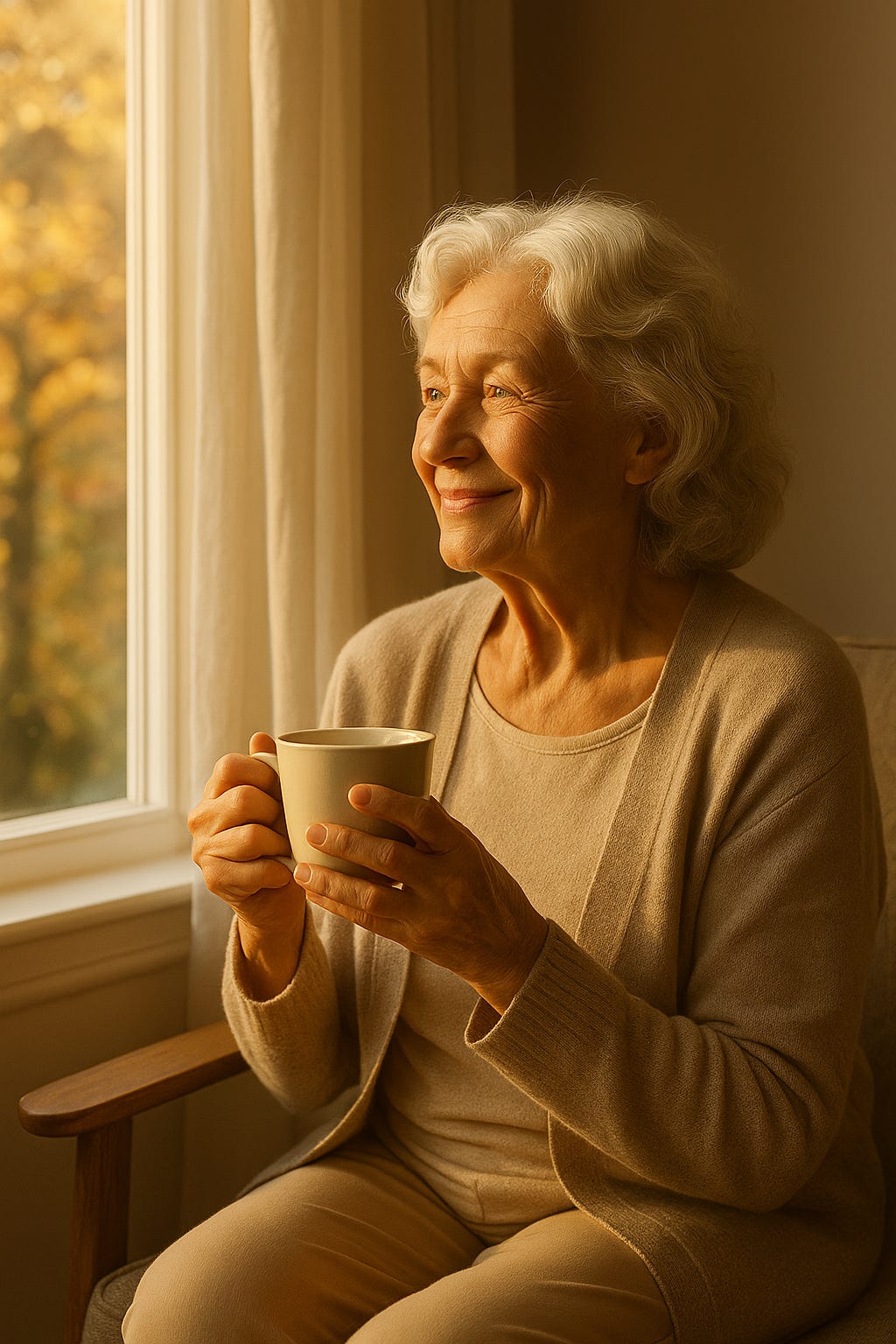The Forgotten Vitamin: Why Vitamin D Matters More After 60
How to get enough sunshine safely and boost immunity in winter
October has that unmistakable feeling — golden light, cooler air, and the quiet rhythm of days growing shorter.
It’s also the month when many older adults unknowingly start running low on one of the body’s most essential nutrients: vitamin D.
For something so small, this “forgotten vitamin” plays a huge role in how we feel, move, and stay healthy — especially as we age. It’s not just about bone strength or immunity (though it helps both). It’s about stability, mood, and resilience through the darker months ahead.
Let’s dig into why vitamin D matters more than ever after 60 — and how you can keep your levels up safely through fall and winter.
“A little sunshine can do more than warm your skin — it can brighten your mood, strengthen your bones, and help keep you steady on your feet.”
🌤️ What Vitamin D Really Does for You
Vitamin D isn’t technically a vitamin at all — it’s a hormone your body makes when sunlight hits your skin. And it quietly supports just about everything that keeps you moving confidently and feeling well.
Here’s what it helps with:
🦴 Bone and muscle strength: Vitamin D helps your body absorb calcium — the building block of bones. Without enough, bones become weaker and more likely to fracture.
💪 Balance and coordination: Studies show low vitamin D levels are linked to increased fall risk, likely because the vitamin affects muscle function and reaction time.
🧠 Mood and mental sharpness: It supports healthy brain chemistry and may help ward off the “winter blues.”
🛡️ Immune defense: Vitamin D helps your immune system recognize and fight off infections more effectively.
❤️ Overall resilience: Emerging research links adequate levels to lower risk of heart disease, cognitive decline, and even some chronic pain conditions.
In short, it’s the quiet helper that keeps your body steady, your mind sharp, and your immune system on guard.
🍂 Why October Is the Turning Point
Once autumn rolls in, sunlight intensity drops — and with it, our natural vitamin D production.
In most northern regions, the sun’s rays in October and November are simply too weak to trigger vitamin D synthesis in the skin. By December, even a long walk outside may not generate enough of the nutrient to meet your needs.
Combine that with spending more time indoors and covering up for warmth, and it’s no surprise that nearly half of adults over 65 have insufficient levels by winter.
That’s why October is the perfect time to act — before the deficit sneaks up and leads to fatigue, low mood, or weaker bones later in the season. Think of it as topping up your internal batteries before winter.
☀️ The Vitamin D–Bone Connection
We often hear about calcium for bone strength — but vitamin D is the gatekeeper that lets calcium do its job. Without enough D, your body can’t absorb calcium efficiently, no matter how much yogurt or milk you eat.
Over time, low levels can lead to osteopenia (bone thinning) or osteoporosis (fragile bones that break easily). That’s especially important for seniors, since bone density naturally declines with age.
But here’s what many people don’t realize:
Vitamin D also affects muscle fibers — particularly those fast-twitch fibers that help you catch yourself if you start to fall. When your levels are low, muscles may respond more slowly, making you more likely to lose balance or stumble.
Multiple studies show that older adults with good vitamin D status have stronger leg muscles and fewer falls.
So when we talk about bone health, we’re really talking about the whole picture: bones, muscles, and stability working together.
💥 The Hidden Cost of Low Vitamin D: Falls and Fractures
Falls are one of the biggest health threats in later life — and often, a preventable one.
Every year, about one in four adults over 65 takes a serious fall. And among those, many experience fractures that can lead to long recovery times or loss of independence.
Vitamin D helps in two powerful ways:
It strengthens bones, so if you do fall, they’re less likely to break.
It improves balance and reaction time, reducing the chances of falling in the first place.
Even mild deficiency — the kind most people don’t notice — can make a difference. That’s why paying attention now can prevent months of pain later.
If you’ve ever felt a bit unsteady getting out of bed or turning quickly, consider that as your body’s gentle nudge: it’s time to check your vitamin D.
🌞 Getting Vitamin D the Natural Way
Your body’s favorite source of vitamin D is sunshine — specifically UVB light. The trick is getting enough without risking skin damage.
Here’s how to do it safely:
Aim for 10–20 minutes of mid-day sun (between 10 a.m. – 2 p.m.) on your face, arms, or hands, 2–3 times per week.
If it’s chilly, try sitting by a bright window or walking outdoors when the sun peeks through — even indirect light helps your mood.
Skip the sunscreen just for those few minutes if you’re outside briefly, then reapply if you’ll stay longer.
Remember: you don’t need to tan or stay out long — your skin makes vitamin D quickly.
And yes, the sun through glass doesn’t produce vitamin D — but it still boosts mood and helps regulate your body’s daily rhythms, so open those curtains wide.
(Pull quote: “Sunshine is free medicine — just take it in safe, daily doses.”)
🥗 Eat Your Sunshine
When sunlight isn’t enough, your meals can help fill the gap.
Focus on foods naturally rich in vitamin D or fortified with it:
🐟 Fatty fish: salmon, sardines, trout, or mackerel (2–3 servings per week).
🥚 Egg yolks: especially from pasture-raised or omega-3–enriched eggs.
🧈 Fortified dairy or plant milks: check labels for added vitamin D3.
🍄 Mushrooms grown under UV light: look for “vitamin D–enhanced” on the package.
🐟 Canned tuna: an easy pantry staple for sandwiches or salads.
If you’re vegetarian or don’t eat much fish, fortified foods and supplements are your best friends.
💊 Should You Take a Supplement?
For many older adults, especially those in cooler climates, sunlight and food alone may not be enough. A supplement can help bridge the gap.
But there’s no one-size-fits-all dose. Here’s a simple guide:
Most experts recommend 800 – 2,000 IU (20 – 50 mcg) per day for adults over 60.
If you’re low or have osteoporosis, your doctor may suggest a higher short-term dose.
Ask for a blood test — it’s the only way to know your actual level.
Choose vitamin D3 (cholecalciferol) — it’s the form your body uses most efficiently.
And remember: more isn’t always better. Too much vitamin D can lead to high calcium levels or kidney strain, so stick to what your provider recommends.
🦵 Pair Vitamin D With Strength and Movement
Vitamin D and calcium are the raw materials — but movement is what turns them into strength.
Try pairing your “sunshine habits” with simple, bone-friendly exercise:
A daily walk outdoors in natural light.
Heel raises or sit-to-stands to strengthen your legs.
Gentle balance work like tai chi or yoga.
Light resistance band exercises for arms and core.
You don’t need long workouts — just small, steady movements that remind your muscles and bones they still have work to do.
(Pull quote: “Strong bones love movement — they get stronger every time you use them.”)
🧣 Little Daily Habits That Help All Winter
Open curtains early to get morning light exposure — it helps both vitamin D and circadian rhythm.
Sit near windows for meals or reading time.
Take your supplement with a meal containing healthy fat (avocado, nuts, olive oil) to boost absorption.
Keep track — mark off days you get sunshine or exercise. Small wins add up.
And yes, even if it’s cloudy — step outside. You’ll still get diffused light, and that crisp air will wake you up better than coffee.
🍁 Why It All Matters
When we talk about vitamin D, we’re really talking about staying strong, steady, and confident as we age.
This one simple nutrient:
Keeps your bones from becoming brittle.
Helps your muscles respond quickly to prevent falls.
Boosts your immune system to fight seasonal infections.
Lifts your mood on shorter, darker days.
It’s not just about avoiding deficiency — it’s about thriving through the seasons.
So as October light filters through the trees, take it as nature’s reminder: open those blinds, eat well, move gently, and let the sun be your daily medicine.
💡 Caregiver Corner
If you’re helping a parent or partner, here are a few ways to support them (and yourself):
Make sunlight part of routine: Sit near a bright window for breakfast or do short outdoor walks together.
Encourage testing: Ask their doctor to check vitamin D levels during regular checkups.
Add fortified foods: Milk, yogurt, or cereal with added D is an easy win.
Pair it with calcium: A simple combo — yogurt with fortified milk, or canned salmon on toast.
Celebrate progress: When they feel steadier or less tired, point it out! Motivation builds confidence.
✨ Your Turn
Do you notice your energy or balance change in the darker months?
How do you get your “sunshine fix” when the weather turns cool?
👉 Share your story in the comments — your experience might be just the encouragement someone else needs this season.




Thank you for the informative article. As someone who has Osteopenia, my doctor advised I stop taking Calcium and remain on Vitamin D and increase my strength training -- which is exactly what I did. AND my numbers improved from my last bone density. As a positive ager whose platform is focused on moving strong, these tips are very helpful. @webbieofwonder
Kathy that’s hot phew 😰 here in the Uk not to cold or rainy at the moment so I 🙏🏼 it carries on that way. xx